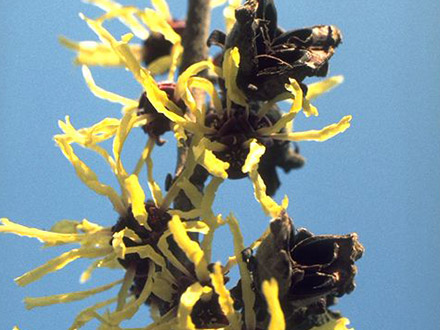Botanical name
Hamamelis virginiana L.
Family
Hamamelidaceae
Common name
Witch hazel, Common witch-hazel, American witch-hazel
Information about the plant
Hamamelis is native to East Asia and the Atlantic states of the American continent, where it grows as a large shrub in thickets and at forest edges from southern Canada to Texas and northern Florida, and in deciduous forests west to Wisconsin, Nebraska, and Missouri. In 1736, Hamamelis was introduced to England under the name "witch hazel" and has since become popular in Central Europe as a hardy shrub in gardens and parks. As a winter bloomer, it adds a touch of color to the gardens in December and January with its yellow flowers. Hamamelis is very similar to our hazel leaves, but its leaves are strikingly skewed and asymmetrical. The flowers are very decorative, with four 1 to 2cm long, thread-like, yellow petals. The fruits grow on woody, two-seeded capsules.
It is not clear how Hamamelis became a genus name, possibly derived from the Greek "hama" (= simultaneous) and "melon" (= apple). The species epithet virginiana refers to the origin of the plant (the US state of Virginia). The English name "witch hazel" is linked to the use of the twigs for water dowsing.
Medicinally used parts of plants (herbal drug)
The dried leaves (Hamamelidis folium) and the dried bark (Hamamelidis cortex) are used.
The commercially available drug is imported from North America.
A preparation known as ‘witch hazel water’ is also commonly used. It is a steam distillate for which different production requirements are in place. According to the United States Pharmacopoeia (USP) monograph, 1kg of freshly cut and dried young twigs is macerated with about 2 liters of water for approximately 24 h, after which the mixture is distilled, and 1700 ml of distillate is collected. Then, 300 ml of alcohol is added and mixed thoroughly; 1 part witch hazel water corresponds to 2 parts Hamamelis twigs (DER 1:2, approximately 15% alcohol content).
The supplementary volume of the German Pharmacopoeia (DAB 6, Erg. B. 6) included a monograph for Hamamelis water (Aqua Hamamelidis corticis). For this, 1000 parts of coarsely powdered dried Hamamelis bark were mixed with 2000 parts of water and 150 parts of alcohol and left to stand for 24 hours. Then, 1000 parts were distilled off, resulting in a DER of 1:1.
Constituents of the herbal drug
Both witch hazel leaves and bark contain tannins. The leaves mostly contain condensed tannins (catechin tannins), while the bark predominantly contains hydrolyzable tannins (gallotannins). Volatile components are also present - sometimes incorrectly labelled as ‘essential oil’. Both drugs consist mainly of alkanes, in addition to aliphatic alcohols, aldehydes, ketones, and esters. It also contains volatile terpenes. Volatile phenylpropanoids occur only in the bark.
When the twigs and/or leaves or bark are distilled, the tannins do not pass into the distillate. Thus, witch hazel water only contains the volatile components of the plant, with leaves and bark differing in their component profiles.
Quality of the drug
The quality of witch hazel (Hamamelis folium) is specified in the European Pharmacopoeia (Ph. Eur.).
- Witch hazel leaves (Hamamelidis folium)
- Witch hazel bark (Hamamelidis cortex)
- Witch hazel leaves fluid extract (Hamamelidis folii extractum fluidum)
- Witch hazel bark fluid extract (Hamamelidis folii extractum fluidum)
Medical applications
Recognised medical use
The HMPC has classified witch hazel leaves, witch hazel and witch hazel bark as traditional herbal medicinal products (see "traditional use").
ESCOP: Witch hazel leaves: Internally for the symptomatic treatment of varicose vein such as aching and heavy legs and haemorrhoids; externally for bruises, sprains and minor skin injuries, inflammation of the skin and mucosa, as well as haemorrhoids, to alleviate the symptoms of eczema and heavy legs. Clinical studies (approval): itchiness, oozing and burning with haemorrhoids grade I and II as well as mucosal inflammation in the anal area.
Witch hazel bark: internally for short-term treatment of diarrhoeal diseases; externally for mouth sores and discomfort associated with varicose veins such as aching and heavy legs. Clinical studies (approval). For relief of symptoms such as itchiness, burning, minor bleeding from haemorrhoids grade I and II inflammation of the mucosa in the anal area.
Witch hazel: externally to treat bruises, skin irritations, sunburn, insect bites, haemorrhoids, also with light skin and mucosal inflammation. Clinical studies (approval): with superficial skin injuries, local inflammation of the skin and mucous membranes (creams), in addition to ointments: for the treatment of haemorrhoids in the early stages (grade I and II).
Traditional use
Witch hazel leaves and bark were classified by the HMPC as traditional herbal medicines (Article 16a of Directive 2001/83/EC). Based upon long-standing use, witch hazel leaves and bark can be applied to minor skin inflammations and dry skin, as well as for treating the itchiness and burning of hemorrhoids, and as rinses or gargling solutions for mild inflammation of the oral mucosa.
Witch hazel water has been classified by the HMPC as a traditional herbal medicinal product (Article 16a of Directive 2001/83/EC). Based upon long-standing use, witch hazel water can be used for mild skin inflammation and dry skin, as well as to relieve eye complaints caused by dryness or exposure to wind and sun.
Herbal drug preparations in finished dosage forms
Witch hazel leaves
- Cut witch hazel leaves for the preparation of an infusion (external use)
- Fluid extract in creams and ointments
- Dried extract in suppositories
- Hamamelis virginiana homeopathic mother tincture in ointments and liquid preparations
- Cut or coarsely powdered witch hazel bark for the preparation of an infusion (externally)
- Dried extract in suppositories
- Distillate of leaves and twigs in ointments, liquids, and lotions
Dosage
Prepared drugs: See patient information leaflet.
Tea infusion: Witch hazel leaves and bark: Use for compresses and rinses 3 times a day, daily dose 2 to 10 g of the drug. Only use witch hazel water as a prepared drug. See the package leaflet for dosage.
Preparation of a tea
For compresses or washes: 5 to 10 g; for gargles and mouthwashes: 2 to 4 g of cut witch hazel leaves or bark, mixed with 250 mL of boiling water and strained after 10 minutes.
Notes
No safety studies are available on the internal and external use of witch hazel leaves and witch hazel bark during pregnancy and lactation.
The use of witch hazel leaves and witch hazel bark in children and adolescents under the age of 18 is not recommended due to a lack of evidence.
The use of witch hazel water is only recommended for children from the age of 6 due to a lack of sufficient evidence. Use on the eyes is only recommended for adolescents from the age of 12 and for adults.
Side effects
Possibly contact allergies.
Interactions
None known.
References
Herbal drug monographs
HMPC (2010, 2019), ESCOP (2012), WHO Vol. 2
Further literature
Commentary on the European Pharmacopoeia (witch hazel leaves, No. 0909; witch hazel bark, No. 2532)


